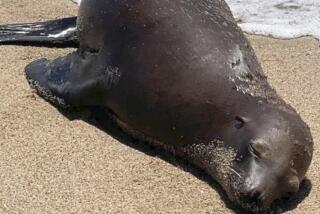Rarely Seen Giant Shark Is Brought to Shore Alive
DANA POINT — A 15-foot megamouth shark, the first of this mysterious species to survive after being brought to shore, was captured early Sunday in a commercial fisherman’s net and hauled by its tail into Dana Point Harbor.
Marine biologists were amazed by the rare catch seven miles off Dana Point, since only four other megamouths have been reported found anywhere in the world. The others were dead or dying when found, but the shark caught Sunday appeared to scientists to be healthy.
With its large bulbous snout, the megamouth looks something like a whale. It is one of the largest sharks in the world and intrigues scientists. Little is known about the species because it thrives in deep waters, and specimens have not been studied or filmed except as corpses.
“It was a really incredible find,” said Robert Lavenberg, curator of fishes at the Los Angeles County Museum of Natural History. “To see it swimming around like that for the first time, it’s mind blowing. It looks like a whale. It’s quite a very odd shark.”
Otto Elliott, a commercial fisherman and skipper of the Moonshiner, said he caught the megamouth in a gill net about 2:30 a.m. while fishing for swordfish and thrasher shark in his 38-foot boat.
Marine experts at the museum hope to film the shark underwater today in the harbor. But they worry that it may not survive in the shallow waters where it has been tied to the Moonshiner since early Sunday.
“This is like an alien coming out of the depths,” said Dennis Kelly, a marine biologist at Orange Coast College. “It’s one in a million. We didn’t even know that they existed until they caught the first one in Hawaii in 1976.
“This is a fabulous opportunity for us, but the animal comes first. You hate to see something like this die,” Kelly said.
Disappointed marine experts worry that they might have to set the deep-sea animal free after videotaping it because there is no place to keep it.
“I’ve been calling my colleagues around the world trying to see if they can save this animal,” Lavenberg said.
Sea World officials in San Diego declined to keep the shark, saying they do not have an available tank large enough and that little is known about what it needs to survive.
“We wouldn’t know how to keep it alive, what food to give it or what kind of lighting is needed,” said Sea World spokesman Dan LeBlanc. “It would take years of research just to accommodate it.”
Megamouths have unusual, cavernous mouths with silvery tissue that might generate light to attract plankton in the dark ocean water that is called the “deep scattering layer.” One mystery shark experts hope to solve by studying the Dana Point creature is whether the tissues actually glow in the dark.
The sharks thrive in ocean waters so deep--at least 700 feet to several thousand feet--that few humans have seen them.
Since the first megamouth was caught off Hawaii in 1976, scientists have been at a loss to explain how such a large creature escaped detection for so long and why they are appearing now.
Scientists are puzzled since the shark caught Sunday was swimming in less than 100 feet of water when trapped in the net.
“If it’s coming to the surface, is it dying? Is it acclimated to those waters? Is it feeding? We just don’t know,” Lavenberg said. “We don’t even know how it swims with that big head. Is it whale-like or porpoise-like in its swimming? The cartilage of the snout is formed like a big bulbous head instead of pointed like a typical shark, so it obviously is not a speed demon.”
The one caught off Hawaii was the only other megamouth taken alive, but it died within hours of swallowing a Navy port anchor, before biologists could see it alive.
The second catch--a 14 1/2-foot megamouth taken off Santa Catalina Island in 1984--is on display at the Los Angeles County Museum of Natural History. It was caught alive, but was dead by the time the boat returned to port.
Two others have washed ashore, one south of Perth, Australia, that was alive but died within hours, and one decomposed carcass found in Japan. All four were about the same size, around 14 1/2 feet, and all were males.
More to Read
Sign up for Essential California
The most important California stories and recommendations in your inbox every morning.
You may occasionally receive promotional content from the Los Angeles Times.










